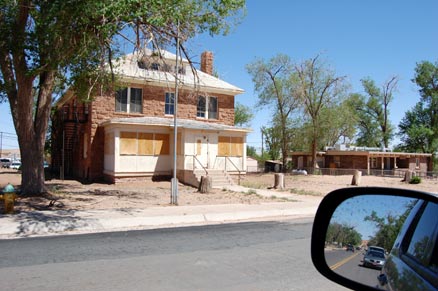
I’d envisioned myself hiking alone in Sedona for three magical days, vortexed into a frenzied energy, taken by wizened hippies to a hillside lair for impromptu meditation. Instead, in spite of the brazenly gorgeous Sedona landscape, I felt the whole place to be a pseudo-spiritual, wildly affluent, corporate-run and supremely phony tourist trap. I was slightly horrified to feel this way about such a beautiful place, and tried to lecture myself into giving further consideration, but to no avail. I got the hell out of Nirvana Dodge after a single (albeit lovely) hike.
That was yesterday. Today I headed north out of Flagstaff on Highway 89 with no particular plan. Shortly after the city faded from the rearview and I was facing the open road, I turned on the radio and heard “You’re listening to Indian Public Radio.” This heralded a perfect Tony Hillerman-esque adventure, I was sure of it, and I was flooded with good cheer.
From the radio came gentle Indian flute sounds, haunting-dancing-with-wolves-vision-quest sounds, which had the hair on my arms standing instantly at attention. Within thirty seconds, however, a techno track and a Navajo-accented rapper barged into the song, resulting in a somewhat bizarre Eminem/Kokopelli kind of thing. I was enthralled.
A retrospective about Harold Drake’s radio show “The Church in Your Hogan” was next, followed by a short discussion of cultural taboos associated with Indian suicide, and an admonition to speak openly about such things. Fleetwood Mac, Peter Frampton, and then this song by some sweet-voiced Hopi girls:
Hey, Cousin! Nice to see you again!
Do you have any duck tape, Cousin? Because my muffler fell off again.
Duck tape. Sigh. Indian glue.
I was becoming giddy.
I took the Navajo Trail (Highway 160) east onto the Navajo reservation and soon came upon Tuba City, a dusty little town of 8,000 residents and seemingly little else. I drove down Main Street and saw house after house boarded up and nothing but dry dusty fields all around. I don’t know where the actual people live, but the town seems reserved for ghosts. In front of the elementary school, at two in the afternoon, were twenty long yellow school buses awaiting what couldn’t possibly be that many kids. In fact I didn’t see any kids, yet one after another the buses pulled slowly away from the curb. Maybe each rural denizen has his or her own bus.
I went into the trading post/interactive Navajo museum ($9)/internet café hoping to find authentic Indian crafts. The store had some very nice moccasins which, on closer inspection, were made by Minnetonka Moccasins — a big corporation headquartered in Minnesota. I tried on a cute black straw cowboy hat made by some beachwear company in Oregon. Then I spied a truly adorable backpack purse of Indian-patterned wool and leather, manufactured — big sigh — by Pendleton, the company responsible for the boiled wool jackets of my Junior League days.
I couldn’t find anything else to do in Tuba City, so I ate some trail mix in the car, drank some warm water from my CamelBack, and did some research on Tuba City. Here are some fun facts:
1. It is the Navajo Nation’s largest community.
2. It was founded by the Mormons in 1872.
3. It was a uranium boom town in the fifties, and regional headquarters for the Atomic Energy Commission.
4. Songwriter-musician Glenn Danzig got his ass kicked in a Tuba City nightclub. It was caught on tape and can be seen on YouTube.
5. SPC Lori Piestewa of Tuba City was the first woman killed in the current war against Iraq. She died in the same ambush that injured her best friend, Jessica Lynch.




